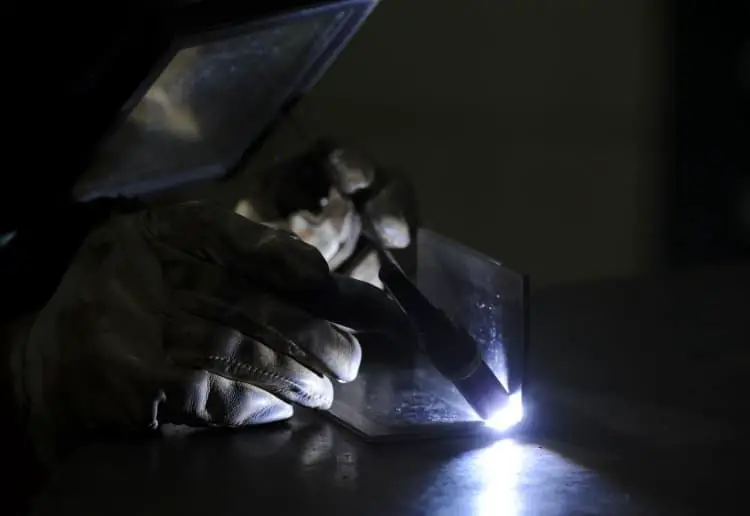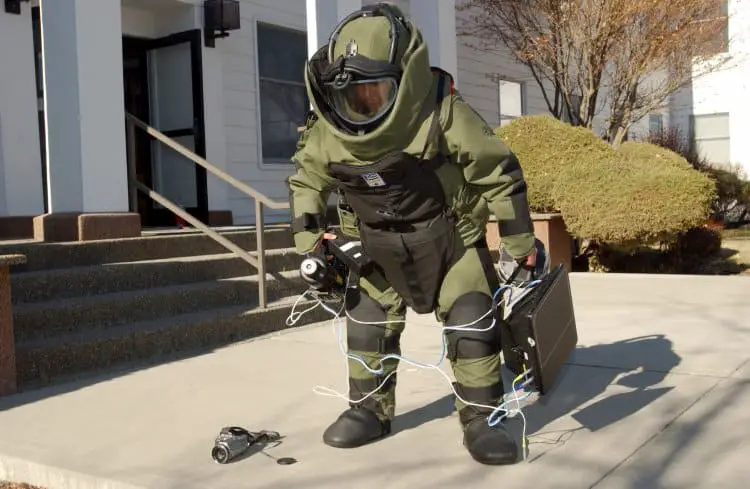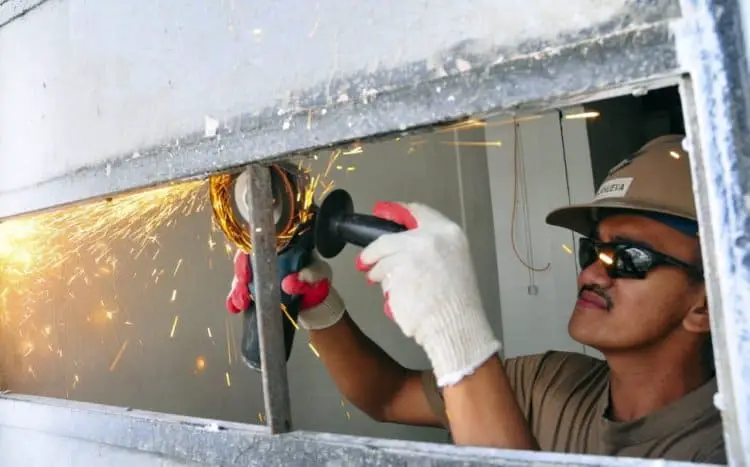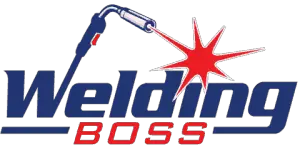This post contains affiliate links to products, services, or education. We may receive a commission for purchases made through links.
TIG welding uses electrodes composed of tungsten with trace amounts of other elements to improve specific traits for welding various metals. One of the most common mixes included with tungsten is thorium – a radioactive element. That seems scary. Are thoriated tungsten electrodes dangerous, and should they be disposed of as hazardous waste when they are used up?
Are used welding rods hazardous waste? Thoriated tungsten rods are not dangerous and can be disposed of like any other waste metal. Once the rods are too short to use, you can toss them in the trash or take them to a metal recycling center.

Note: TIG welding requires you to use a metal rod in each hand. One is the tungsten electrode that creates the arc and is mostly non-consumable. The other is the rod of filler metal used to make the weld, which is used up as you weld. In this article, we are talking about the electrodes – not the filler rods.
How Much Thorium Is There In A Tungsten Electrode, Anyway?

Thoriated tungsten electrodes come in two grades, 1% and 2%. The percentage is the amount of thorium in the rod.That means that TIG electrodes are either 98% or 99% tungsten. A single rod contains less than half a gram of thorium. It also helps that the thorium is alloyed with the tungsten. Whatever radiation is released by the thorium is trapped by the tungsten, so it never reaches you.
For comparison, a paperclip weighs one gram. So a seven-inch electrode has enough thorium mixed in to make half a paperclip – barely any at all.
You could carry a thoriated electrode in your hand all day, every day for a year and not receive a dangerous dose of radiation.
Tungsten Electrode Disposal Options
Tungsten electrodes are considered non-consumable, but they do wear down over time.
The electrode should have a sharp tip to create a stable arc. This tip gradually melts to a round blob as you weld, requiring the tip to be ground sharp again. Purpose-built electrode sharpeners are available that put a perfect point on your electrode every time. However, many welders like to use the good old bench grinder instead.
Recycling Your Thoriated Tungsten Electrode
Over time, the sharpening process wears the electrode down.
Eventually, the electrode becomes too short to fit in your welder’s handpiece, requiring you to get rid of it. If you do enough TIG welding, you can save the tips until you head to the scrapyard with a load of old iron.
Many scrap yards are in the market for tungsten as well as other metals.
Drop Off Your Old Electrodes
If you do not weld enough to justify saving electrodes, you might be able to drop off used electrodes at your welding supply house. Ask the next time you are buying project supplies.
The final option is to chuck the old electrodes in the trash.
The Environmental Protection Agency doesn’t restrict the disposal of thoriated tungsten rods, so there is no federal rule against it.
You should check your state and local regs, just in case.
Donate Old Electrodes To A School
If you want to get rid of thoriated tungsten rods that still have some life in them, consider donating the rods to a local high school or vocational college.
Students can get much learning out of your old rods, and it will help stretch the school’s budget.
The Real Danger of Thoriated Tungsten

Thoriated tungsten rods are fine to use, to carry, and to throw away. However, there is one danger that you should be aware of.
Dust from thoriated tungsten rods is carcinogenic if you breathe it.
When you grind the rods, wear a respirator (see our recommended respirators here), or use a dust capturing setup. Breathing in the dust from thoriated rods traps the radiation in your lungs instead of the tungsten. Yes, that is as bad as it sounds.
You really should wear a mask when you use a grinder anyway. Breathing any metal dust isn’t healthy for you and will eventually lead to lung problems.
Aluminum, iron, steel, and non-thoriated tungsten won’t give you cancer, but they will cause other problems.
Wear a mask unless you want your lungs to look like a coal mine.
Alternatives to Thoriated Tungsten
Thoriated tungsten electrodes have become the standard for TIG welding because they are long-lasting, have a very stable arc, and work with AC and DC welding.
There are no standard electrodes that have the same characteristics as thoriated tungsten.
Still, you can find a rod that handles any specific job as well or better. If you want to use a different rod, here are some excellent choices:
- Pure tungsten is the least expensive type of electrode. It is suitable for high heat levels and reverse polarity welding. Pure tungsten provides a stable arc, but the end balls quickly
- Ceriated tungsten is considered the most similar to thoriated tungsten. It’s great for lower voltages, thin stock, and AC welding. Ceriated tungsten is a useful all-around TIG electrode.
- Lanthanated tungsten is a solid choice for welding with non-ferrous metals and stainless steel. It is quite easy to strike an arc with lanthanated electrodes. Some blends are suitable for both AC and DC, while others are DC-only.
- Zirconiated tungsten is the choice for hot, high-amperage AC welds. It keeps a balled tip and is the best electrode to eliminate tungsten contamination. It does not do well with DC welds, however.
- Rare-earth electrodes may contain a variety of additives. Unlike the other rods that have a specified percentage of a specific element, rare-earth electrodes are made in unique, proprietary blends by electrode makers. One company’s rod will be different than another, so you have to check out these electrodes on a case-by-case basis.
Each manufacturer is required to label the blend on the rod packaging, so you know what you are getting.
Choosing a rare earth electrode is an exercise in the specialization. You need to know what kind of welding you prefer and how you like to run your TIG welder before you can choose a rare-earth electrode.
None of these rods contains radioactive material, so if you are worried about radiation, you are safe here.
You should still wear a respirator when you grind these rods because breathing metal particles is not a win for you.
Other Electrodes and Rods
Aside from thoriated tungsten electrodes, other electrodes, TIG filler rods, and arc welding rods do not have hazardous ingredients at all.
Steel, iron, aluminum, and tungsten aren’t dangerous. You can use them up, recycle them, or give them away without worry.
You probably shouldn’t throw old rods away just because they can be used or recycled by someone else. Save the landfill space for real garbage.
Leftover arc welding rods and TIG filler sticks can be tossed in your recycle pile with cutoff bits of metal, old screws, and the odds and ends that welders throw away. Just make sure to separate it by type so that you can get the highest price for exotic metals.
Don’t Worry About It
Thoriated tungsten electrodes are not defined as hazardous waste by the EPA.
You are allowed to throw them away, although recycling or donating them is a better use of the metal. They are safe to handle, store, and use. However, if you are anxious about thoriated tungsten, other rods are available.
The real danger from any tungsten electrode is the dust from grinding.
Wear a respirator when you sharpen electrodes – and when you grind other metals, too. Metal dust in your lungs is no joke; it kills you much faster than cancer from thorium in electrodes.
Wear your respirator, crack an arc, and weld without fear.
